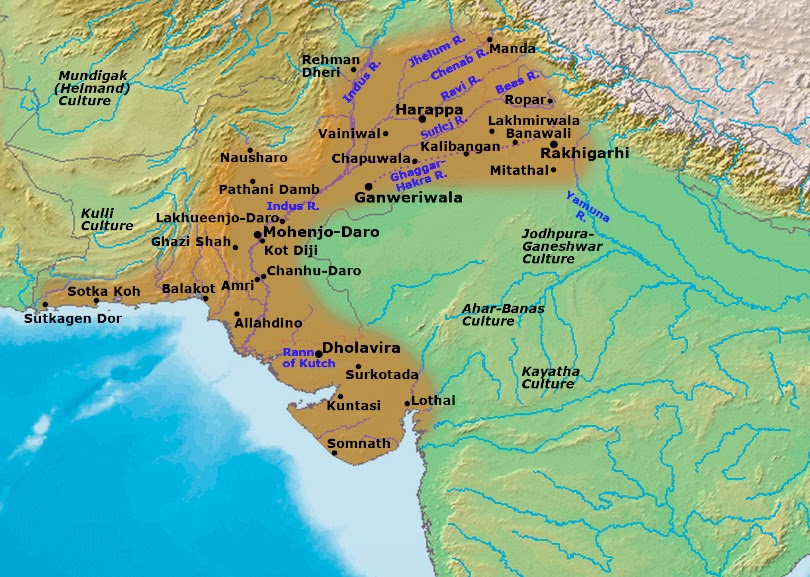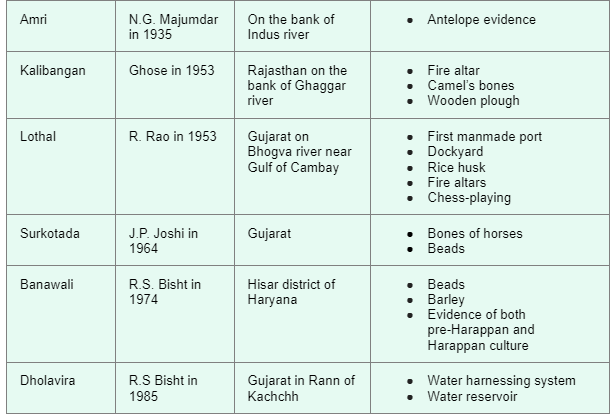Indian History
100 years of Discovery of IVC
- 23 Sep 2024
- 10 min read
For Prelims: Harappan Civilization, Archaeological Survey of India (ASI), Indus Valley Civilization (IVC), Aryans
For Mains: Key features of Indus Valley Civilization, Town Planning, Religion and Decline of Indus Valley Civilization, Contemporary Civilizations its Key Features
Why in News?
20th September 2024, marked 100 years since the discovery of the Indus Valley Civilization, which was announced by archaeologist Sir John Marshall on 20th September 1924.
- This civilization spans over 2,000 sites across 1.5 million sq. km in India, Pakistan, and Afghanistan and is famous for its advanced urban planning and architecture.
What was Harappan Civilization?
- About:
- The Harappan Civilization, also known as the Indus Valley Civilization (IVC), flourished around 2500 BCE along the Indus River .
- It was the largest of the four ancient urban civilizations alongside Egypt, Mesopotamia, and China.
- The IVC is classified as a Bronze-age civilization due to the discovery of numerous artefacts made from copper-based alloys.
- Daya Ram Sahni first excavated Harappa in 1921-22, and Rakhal Das Banerji began excavating Mohenjo-daro in 1922.
- Sir John Marshall, DG of ASI, was responsible for the excavations that led to the discovery of Harappa and Mohenjo-Daro sites of IVC.
- Phases:
- Early phase (3200 BCE to 2600 BCE): This phase is associated with the Hakra Phase, which was discovered in the Ghaggar-Hakra River Valley. The earliest Indus script dates back to 3000 BC.
- Mature period (2600 BCE to 1900 BCE): By 2600 BC, the IVC had reached a mature stage. Early Harappan towns, like Harappa and Mohenjodaro in Pakistan and Lothal in India, were growing into major urban centres
- Late phase (1900 BCE to 1500 BCE): In this phase, Harappan civilization decayed and collapsed.
What were the Important Sites of Harappan Civilization?
What were the Key Features of Harappan Civilization?
- Town Planning:
- The Harappan culture was notable for its advanced town planning with cities designed in the grid-like layout.
- Both Harappa and Mohenjodaro featured a citadel or acropolis, likely occupied by the ruling class.
- Below these citadels lay the lower towns, consisting of brick houses inhabited by common people.
- Granaries of large size were used to store grains, and there was widespread use of burnt bricks, which is different compared to the dried bricks used in contemporary Egyptian structures.
- Mohenjodaro had an impressive drainage system, and almost all houses had courtyards and bathrooms.
- In Kalibangan, many homes even had private wells.
- At sites like Dholavira and Lothal in Gujarat, the entire settlement was fortified, with internal sections divided by walls.
- Agriculture:
- Harappan villages, primarily located near floodplains, were highly productive, yielding crops such as wheat, barley, peas, sesame, lentils, chickpeas, rai, and mustard.
- Millets were also cultivated, particularly in Gujarat, though rice was rare. The Indus people were among the first to produce cotton (Greeks called it “Sindon”).
- While agricultural activity is evidenced by grain remains, reconstructing specific farming techniques is challenging.
- In addition to farming, animal husbandry was widespread.
- Economy:
- Trade played a vital role in Harappan life, evident from the widespread use of seals, a uniform script, and standardised weights and measures.
- Major trade items included stone, metal, and shell.
- The barter system was used, as metal currency did not exist.
- Navigation was practised along the Arabian Sea coast.
- A trading colony in northern Afghanistan facilitated commerce with Central Asia.
- The Harappans engaged in trade with Mesopotamia (Tigris-Euphrates region).
- Long-distance trade in lapis lazuli (blue semi precious stone) likely enhanced the social status of the ruling class.
- Crafts:
- Harappans were skilled in bronze manufacturing, using copper from Rajasthan (Khetri mines) and tin possibly from Afghanistan.
- Textile impressions on objects suggest a knowledge of weaving.
- Key crafts included boat-making, bead-making, seal-making, and terracotta production.
- Goldsmiths crafted jewellery from gold, silver, and precious stones.
- The potter's wheel was widely used, producing glossy, distinctive pottery.
- Religion:
- Numerous terracotta figurines of women suggest worship of a fertility goddess, similar to the Egyptian goddess Isis.
- A male deity, identified as Pashupati Mahadeva (in yogi posture), is depicted on a seal with three horned heads, surrounded by animals like elephants, tigers, rhinoceros, and buffalo.
- Symbols of the phallus (male sex organ) and female sex organs indicate fertility worship.
- The Harappans worshipped animals and trees, with the unicorn (possibly a rhinoceros) and the humped bull being significant.
- Amulets were commonly found, likely used for protection or religious purposes.
What were the Possible Reasons for Decline of Harappan Civilization?
- Invasion Theory: Some scholars suggest that Indo-European tribes, known as the Aryans, invaded and overthrew the IVC. However, evidence of cultural continuity in later societies challenges this abrupt invasion narrative.
- Natural Environmental Changes: More widely accepted is the impact of environmental factors.
- Tectonic Activity: Earthquakes may have altered river courses, leading to the drying up of essential water sources.
- Changes in Rainfall Patterns: Shifts in monsoon patterns could have diminished agricultural productivity, resulting in food shortages.
- Flooding: Altered river courses might have caused flooding in key agricultural areas, further threatening the civilization’s stability.
Recent Initiatives Related to IVC Sites
- National Maritime Heritage Complex (NMHC): Under the Sagarmala programme, the Ministry of Ports, Shipping, and Waterways (MoPSW) is developing a NMHC at Lothal. It includes a museum, theme parks, a research institute, and more, to showcase India's maritime history and heritage, and attract tourists.
- Dholavira added to UNESCO's World Heritage list: In July 2021, Dholavira was named India's 40th World Heritage Site by UNESCO.
- Development of Rakhigarhi as an Iconic Site: Union Budget (2020-21) has proposed to develop Rakhigarhi (Hisar district,Haryana) as an iconic site.
UPSC Civil Services Examination, Previous Year Questions (PYQs)
Prelims
Q. Regarding the Indus Valley Civilization, consider the following statements: (2011)
- It was predominantly a secular civilization and the religious element, though present, did not dominate the scene,
- During this period, cotton was used for manufacturing textiles in India.
Which of the statements given above is/are correct?
(a) 1 only
(b) 2 only
(c) Both 1 and 2
(d) Neither 1 nor 2
Answer: (c)
Q. Which of the following characterize/characterises the people of the Indus Civilization? (2013)
- They possessed great palaces and temples.
- They worshiped both male and female deities.
- They employed horse-drawn chariots in warfare.
Select the correct statements using the codes given below:
(a) 1 and 2 only
(b) 2 only
(c) 1, 2 and 3
(d) None of the above
Ans: (b)
Mains
Q1: The ancient civilisation in the Indian sub-continent differed from those of Egypt, Mesopotamia and Greece in that its culture and traditions have been preserved without a breakdown to the present day. Comment. (2015)
Q2: To what extent has the urban planning and culture of the Indus Valley Civilization provided inputs to present-day urbanization? Discuss. (2014)









